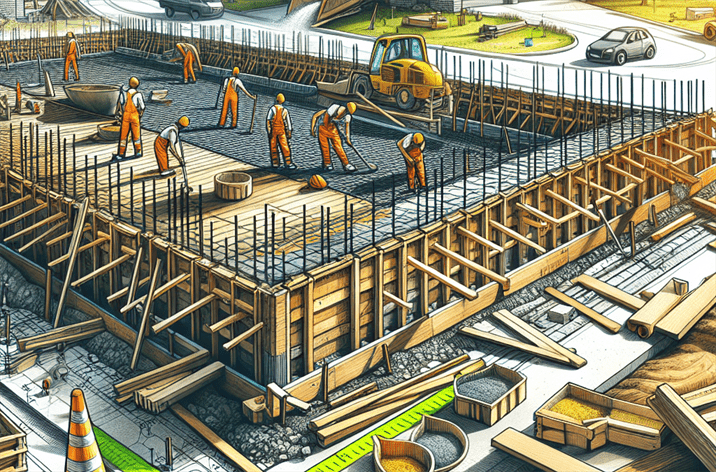Lath Survey Stakes: Essential Tools for Precise Marking
Introduction
When it comes to construction, precision is paramount. Did you know that lath survey stakes have been vital tools in construction and surveying for centuries? These simple yet effective markers have evolved significantly over time, yet their fundamental purpose remains unchanged: to ensure accuracy in measurements and layouts. Lath survey stakes are not just wooden sticks; they represent a crucial aspect of the construction process, ensuring that every structure is built correctly and efficiently.
In modern construction, lath survey stakes play an indispensable role. They assist surveyors and construction workers in marking boundaries, outlining building layouts, and ensuring that every element of a project is perfectly aligned. The accuracy provided by these stakes can significantly impact the success of a project, preventing costly mistakes and delays. In this article, we will delve into the essentials of lath survey stakes, exploring their applications, benefits, challenges, and best practices for optimal use.
For further insights on using lath survey stakes effectively, check out our guide on Optimal Construction Stakes and Lath Usage.
What is Lath Survey Stakes?
Definition
Lath survey stakes are slender wooden or plastic stakes used in surveying and construction to mark specific points on a site. They serve as reference points for measuring distances and angles, guiding construction activities, and delineating property boundaries. Typically, these stakes are driven into the ground and can be easily seen, making them ideal for marking important locations on a job site.
Historical Context
The history of lath survey stakes dates back to ancient civilizations, where basic forms of marking were used for land division and construction. Over time, as construction techniques advanced, so did the design and application of these stakes. The early wooden stakes were often crudely shaped and lacked consistency. However, with the advent of industrialization and improved woodworking techniques, lath survey stakes became standardized, allowing for more accurate and reliable measurements.
The Importance of Lath Survey Stakes
In today’s construction landscape, the importance of lath survey stakes cannot be overstated. They are essential tools used across various industries, from civil engineering to landscaping. Their ability to provide clear visual markers makes them invaluable for ensuring that construction projects are executed with precision. The stakes help in maintaining alignment, defining boundaries, and ensuring compliance with local regulations.
Lath Survey Stakes in the Context of Civil Engineering
In civil engineering, lath survey stakes are critical for defining project boundaries and elevations. They are commonly used during the initial stages of construction to outline the layout of roads, bridges, and buildings. Their use ensures that all elements are positioned correctly, contributing to the overall structural integrity of the project.
Key Players or Contributors
Several manufacturers have made significant contributions to the development of lath survey stakes. Innovations in materials and designs have enhanced their durability and usability. For instance, companies specializing in construction supplies have introduced eco-friendly wooden stakes that not only serve their purpose but also align with sustainability goals. Such developments have made lath survey stakes more accessible and efficient for builders and surveyors alike.
For more on the significance of these tools, read about Advantages of Construction Stakes and Lath.

How Does Lath Survey Stakes Work?
The Mechanics of Lath Survey Stakes
Understanding how lath survey stakes work is crucial for their effective application. When a surveyor or construction worker drives a stake into the ground, it serves as a reference point for various measurements. The height of the stake can indicate elevation, while its position can mark property lines or the corners of a construction site. By using multiple stakes, professionals can create a grid or layout that guides the entire construction process.
Technological Foundations of Lath Survey Stakes
The effectiveness of lath survey stakes is supported by advancements in materials and technology. Traditionally made from wood, modern stakes can also be constructed from durable plastics or composites that resist weathering and damage. Innovations like reflective markers can enhance visibility, especially in low-light conditions, improving accuracy during the surveying process. Additionally, technology such as laser levels can complement the use of lath survey stakes, allowing for even greater precision in construction layouts.
Real-World Applications of Lath Survey Stakes
Lath survey stakes are utilized in various real-world applications, ensuring accuracy and efficiency in construction projects. Here are some notable examples:
- Boundary Marking: In landscaping and property development, lath survey stakes delineate property lines, ensuring compliance with zoning laws.
- Site Layout: Construction teams use stakes to outline the footprint of buildings, ensuring that foundations are laid out accurately.
- Grading: Surveyors utilize lath stakes to establish grades for drainage and landscaping, preventing future issues with water runoff.
This versatility makes lath survey stakes an essential tool for any construction project.
Benefits of Using Lath Survey Stakes
Enhanced Accuracy
One of the primary benefits of using lath survey stakes is the enhanced accuracy they provide. By clearly marking points and lines, these stakes minimize the risk of errors in measurements and layouts.
Cost-Effectiveness
Lath survey stakes are a cost-effective solution for marking and surveying. They are relatively inexpensive compared to other surveying tools and can be reused for multiple projects, reducing overall costs.
Ease of Use
These stakes are straightforward to use, requiring minimal training or expertise to implement. This accessibility allows even novice workers to participate in the surveying process effectively.
Environmental Benefits
With the rise of eco-friendly materials, many lath survey stakes are now made from sustainable wood sources, aligning with environmental construction practices. This shift not only supports sustainability but also resonates with modern consumers who prioritize eco-friendly products.
Challenges and Best Practices
Challenges in Using Lath Survey Stakes
Despite their many advantages, there are challenges associated with using lath survey stakes. Weather conditions, such as heavy rain or strong winds, can affect their stability and visibility. Additionally, improper placement can lead to inaccurate measurements, making it essential for users to be meticulous in their approach.
Best Practices for Effective Use
To maximize the benefits of lath survey stakes, follow these best practices:
- Choose the Right Materials: Select stakes made from durable materials that can withstand environmental conditions.
- Proper Placement: Ensure stakes are driven into the ground firmly and at the correct angles to maintain stability.
- Regular Inspections: Periodically check the stakes to ensure they remain in position and are not affected by external factors.
- Use Additional Markers: Combine lath survey stakes with other markers, such as flags or paint, for enhanced visibility.
By adhering to these best practices, construction professionals can ensure the effective use of lath survey stakes, contributing to the overall success of their projects.
Future Trends in Lath Survey Stakes
Innovations in Materials
As sustainability becomes a priority in construction, the future of lath survey stakes will likely see advancements in materials. Expect to see more eco-friendly options, including biodegradable stakes that do not harm the environment.
Integration with Technology
The integration of technology into surveying practices is set to grow. Future developments may include stakes with built-in sensors that provide real-time data on positioning and elevation, enhancing accuracy and efficiency in construction processes.
Increased Customization
As construction projects become more specialized, the demand for customizable lath survey stakes will rise. Manufacturers may begin offering stakes in various sizes, colors, and materials to suit specific project needs.
Conclusion
Lath survey stakes are indispensable tools in the construction and surveying industries, providing accuracy and reliability in marking and measuring. Their historical significance, coupled with modern advancements, underscores their continued relevance in today’s construction practices. By understanding how to effectively use these stakes, construction professionals can ensure the success of their projects while navigating the challenges that may arise.
Whether you are a seasoned contractor or a novice in the construction field, integrating lath survey stakes into your workflow can enhance your project outcomes. As innovations continue to shape the future of construction, staying informed about these essential tools will be crucial for maintaining competitive advantages in the industry.
Explore more about lath survey stakes and their applications by diving into our detailed articles on construction alignment tools and effective surveying practices.
Resource Links:
1. Wood Magazine – Overview of lath survey stakes and their uses in construction and surveying.
2. Engineering Toolbox – Information on different types of survey stakes, including lath stakes, and their applications.
3. National Geomatics – Details on survey stakes, focusing on lath stakes and their significance in land surveying.

